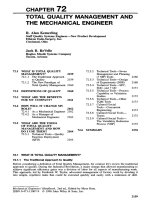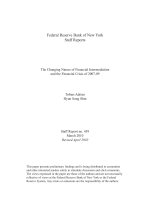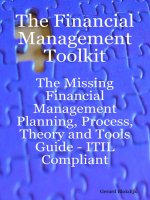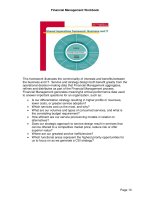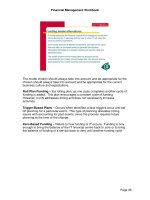Health Facility Financial Management and the Indice Tool
Bạn đang xem bản rút gọn của tài liệu. Xem và tải ngay bản đầy đủ của tài liệu tại đây (203.92 KB, 16 trang )
CHAPTER 7
Health Facility Financial
Management and the Indice Tool
Lack of money is the root of all evil.
—George Bernard Shaw
MAIN MESSAGES
➜
➜
➜
Cash income of health facilities can be from different sources, including
PBF. The indice tool helps the in-charge person of the health facility to
manage holistically all sources of cash income and expenses and to allocate a performance-based share of the profits to each health worker.
PBF makes health workers shareholders in the financial health of their
health facility.
Individual health-worker effort is rewarded each month. If you work
harder, you receive a higher performance bonus. If you work less, then
you receive a lower performance bonus.
149
COVERED IN THIS CHAPTER
7.1
7.2
7.3
7.4
7.5
7.6
Introduction
General sources of cash income of a health facility
Verification of the amounts
The processing of payments to health facilities
The indice tool
Links to files and tools
7.1 Introduction
Cash income of health facilities can originate from different sources, including performance-based financing (PBF). In PBF, building capacity to handle
this cash at the facility level in an integrated and accountable manner is crucial. The indice tool helps the in-charge person of the health facility to manage all sources of cash income and expenses and to allocate a performancebased share of the profits to each health worker.
Linking results to money requires good accountability structures to be in
place:
• Produce good-quality results data to confirm if the intended results have
been achieved.
• Introduce accountability mechanisms for the governance of the public
funds, which in turn promotes civil society and community involvement.
• Use budget disbursement as a proxy indicator for total performance,
which can lead to good benchmarking of providers.
7.2 General Sources of Cash Income
of a Health Facility
PBF is premised on cash being handled by health facilities. Possible sources
of cash income for a health facility are (a) out-of-pocket payments; (b) fixed
cash support from government or aid agencies, for instance, to pay for basic salaries or operational expenses; (c) income from health insurance payments; and (d) payments of PBF subsidies or cash from other sources. The
exact mix of cash income sources depends largely on context.
Especially in the PBF design phase, determine what existing cash sources
are available and how much each of those sources contributes to the total
income of a health facility. The possible scenarios range from cases in which
no formal cash income reaches the facility to those in which the sources
150
Performance-Based Financing Toolkit
of income are well diversified. Ideally, a health facility should have a welldiversified income spectrum, to which PBF would be additional income.
PBF is supposed to leverage all productive resources: land, buildings, equipment, medical supplies, and human resources, as well as all cash income.
The indice tool was developed for transparent management of cash income. This tool helps manage all sources of cash income in an integral
fashion.
7.3 Verification of the Amounts
For PBF cash payments to be transferred to the health facility level for the
delivery of quality services, the amounts due are verified at different levels
(see box 7.1):
• The amounts are verified at the health facility level by the management and
the health center committee, who scrutinize the invoice before approving
it (see the sample health facility invoice in the links to files in this chapter).
• The amounts are verified monthly at the health facility level by the purchaser’s verifier, who verifies the quantity performance in the registers
and approves the monthly invoice (see chapter 2).
• The amounts are verified quarterly at the level of district or provincial
PBF steering committee meetings in which the quantity and quality performance is validated and the consolidated district invoice is approved.
• The amounts are verified at the level of the purchaser, who executes a due
diligence of procedures (steering committee meeting minutes, signed and
validated district invoices) for the production of a consolidated payment
order and its submission to the fund holder (see the sample consolidated
quarterly invoice in the links to files in this chapter).
• The amounts are verified at the level of the fund holder, who transfers the
funds to the health facilities.
BOX 7.1
Decentralized Decision Making on PBF Results in Nigeria
In the Nigeria State Health Investment Project
(NSHIP) decisions on the amounts to be paid are
made at a decentralized level (figure B7.1.1). The
local government authority (LGA)—the district
level—has a newly constituted body called the
LGA Results-Based Financing (RBF) Steering
Committee. At this decentralized level, the results of the quantity performance (the amounts
(box continues on next page)
Health Facility Financial Management and the Indice Tool
151
to be paid based on the volume of services) and
the quality performance (the quality score determined quarterly for each health facility) are scrutinized. By use of a web-enabled application, a
consolidated quarterly invoice is created for each
district RBF steering committee. In the district
steering committee meetings, the proof of actual performance (the original monthly invoices
and the results of the quarterly quality evaluations) is compared against the district invoices
printed from the database. The steering committees are the governing boards for PBF. They include the local government authority, the state
ministry of health, the purchaser (the state primary health care development agency), and civil
society representatives.
In these decentralized meetings, performance is ratified. Higher levels (the purchaser
and the fund holder) carry out due diligence
only on procedures.
FIGURE B7.1.1 NSHIP PBF Administrative Model
SMOH/SPHCDA/
Partners
Technical Support
LGA RBF Steering Committee
Authorization
Fund
Holder(s)
Payment
Service
Provider:
HC/General
Hospitals
Submission of Results
LGA PHC
Dep.:
Quality
Evaluator
C
PB
SPHCDA
Purchaser
Quantity
Evaluator
Follow-up
and Client
Satisfaction
Surveys
Beneficiaries
Source:: World Bank data.
data
Note:: HC = health center; LGA = local government authority; NSHIP = Nigeria
State Health Investment Project; PBC = performance-based contracting;
PHC = primary health care; PBF = performance-based financing;
RBF = results-based financing; SMOH = state ministry of health;
SPHCDA = state primary health care development agency.
152
Performance-Based Financing Toolkit
7.4 The Processing of Payments
to Health Facilities
Once the parties agree on performance payments, the money should be
transferred directly from the fund holder to the health facility’s bank account. There should be as little delay as possible in paying for performance.
However, in practice, paying for actual performance through the public financial management structures can still be tedious and time consuming, as
is illustrated in box 7.2.
In each PBF scheme, some details on payment to health facilities need to
be formulated, such as the following:
•
•
•
•
The initial performance payment
The frequency of payment
Lack of banking facilities
Accounting for the money.
BOX 7.2
Payment for Performance in Burundi
In the Burundi PBF system, a quasi-public purchaser approach, payment for performance can
take between 43 and 50 working days. The various fund holders (about 10 in total in the country) have different payment cycles. The cycle
that takes most time—that is 50 days—belongs
to the public fund holder, which currently pays
about 70 percent of all the PBF expenses in Burundi. For the public fund holder, the various
steps in the payment cycle are (a) creation of
the invoice for the previous month by the health
facility (5 days); (b) verification at the source of
the monthly invoice by the provincial purchaser
(14 days); (c) data validation by the provincial
purchaser (1 day); (d) synthesis, compilation,
due diligence, and transmission of payment order to the General Resources Directorate
Health Facility Financial Management and the Indice Tool
(5 days); (e) due diligence by the General Resources Directorate and transfer of payment
request to the Ministry of Finance (3 days); and
(f) payment by the ministry to health facilities
(21 days). Payment for quantity production is
monthly. Each quarter, the third month’s production is combined with the additional quality bonus based on the quality obtained. However,
even though the procedures seem long, the
previous system for reimbursing providers for
selective free health care services (for pregnant
women and children under five years of age) often took up to six months. The processing time
changed after scaling up PBF in April 2010. Currently, the Burundi PBF system combines funding for PBF with funds available for selective
free health care.
153
The Initial Performance Payment
Health staff may have a long wait for the first performance payment. Consider this issue when scaling up PBF. Staff members may have heightened
expectations: they have worked hard to make a difference, yet must wait two
months after the end of the first quarter to receive their first payment (up
to five months into the program). This initial delay in rewards can create
resentment. Two ways of dealing with this delay are (a) to introduce quality improvement units and to finance the business plan (see chapter 9) and
(b) to allow a lump-sum payment by the end of the second month into the
next quarter of the PBF program (for the previous quarter’s performance).
A lump sum will demonstrate to the staff that PBF is a reality, and it can
help kick-start the quarterly payment cycle (because the payment for the
first quarter will arrive in month five).
The Frequency of Payment
Payment is best made once a quarter. Although payment could be monthly,
as in Burundi it is probably easier for the system to pay once per quarter. The
indice tool not only helps the health facility manager distribute performance
bonuses quarterly (by dividing the bonus portion over three months), but
also assists in the financial planning.
Lack of Banking Facilities
Some health facilities have no access to formal banking services. An absence
of formal banks can be an obstacle for PBF, and creative thinking is often
needed to find a solution, as illustrated in box 7.3.
Accounting for the Money
Accounting for the money is part and parcel of PBF practice. For the funds
they handle, health facilities use income and expense registers to document
their daily cash flows. The quarterly income-expense statement, which is
part of the PBF indice tool (see section 7.5) and the business plan (see chapter 10), is used by the health facility management committee, the purchasing
agency, and the district health management. Health facility staff members
are involved closely in deciding how much to spend on what. Their management regularly informs them about their individual performance evaluations and performance bonus payments. Health facility staff members are
also closely consulted when an investment must be made that would require
154
Performance-Based Financing Toolkit
BOX 7.3
Getting Money to Facilities
In South Kivu province, the Democratic Republic of Congo, Cordaid, a Dutch nongovernmental
organization, has been managing a multisectoral PBF project since 2007. In this far-away region, health facilities could not open an account
at a formal bank. The only bank branches were
in the province’s capital, Bukavu. Cordaid decided to use agricultural cooperatives and microcredit lenders. Although those institutions
are not banks, they are registered and legitimate entities. Shabunda did not have even an
agricultural cooperative, which meant that Cordaid initially had to use cash in an unsafe area.
As a solution to this problem, the start-up
costs of a cooperative were financed (which
amounted to less than US$20,000). Today,
Shabunda has a bank that traders and the purchasing agent use. With these arrangements,
there have been no problems transferring
money from the purchasing agent to the health
facilities.
In Chad, a World Bank–funded project employs a performance-purchasing agency, the Eu-
ropean Agency for Development and Health
(AEDES) to carry out the purchasing function on
behalf of the government. Chad has very low
banking coverage. PBF is implemented in eight
remote districts. For security reasons, AEDES
was not willing to transport cash from a bank to
the 120 contracted facilities. Initially, AEDES
thought this lack of transportation would pose a
major obstacle. In reality, there were many
more options on the ground than the agency
had accounted for. Money transfer agencies,
microcredit institutions, and church-based payment systems were willing to step in. Ultimately, almost half the contracted facilities
opened a bank account at an express union—a
local money transfer agency that was ready to
open a separate account for each facility. The
other half of the facilities used the services of a
microcredit agency (such as caisses d’épargne
et de retraite de Koumra, PARCEC, Moissala,
and CECI Lai). Five health facilities (mostly hospitals) opted to open an account in an official
bank.
forfeiting part or whole of their performance bonuses. Making staff members of a health facility stakeholders in the financial health of their facility
involves intense teamwork and a large degree of financial transparency and
shared decision making. Health facilities can be subject to routine financial
audits by the public administration.
7.5 The Indice Tool
The indice tool is a financial management tool that helps the manager
(a) manage all cash income and expenses of the facility in a holistic
and integrated manner; (b) provide a summary snapshot on the income
and expense statements of the health facility and, therefore, is also a
Health Facility Financial Management and the Indice Tool
155
budget planning tool; and (c) allocate performance bonuses to individual health workers in a transparent manner.
The indice tool exists in a paper form and in a Microsoft Excel form (see
box 7.4). In this section, the paper form is presented. For guidance on using
the Microsoft Excel form, see the document explaining its functionality in
the links to files in this chapter. The Microsoft Excel form is typically used
in larger facilities that have access to electricity and computers. The paper
form is mostly used in smaller facilities such as health centers.
The Paper-Based Indice Tool
The indice tool exists in many variants. The example used here is from Nigeria (see the links to files in this chapter). The Nigerian tool contains four
sections:
a. Revenues and expenses for the past quarter: statement of quarterly financial activities
b. Revenues and expenses for the past month and proposed monthly revenues and expenses for the next quarter
c. Budget for performance bonuses; point value and monthly performance
bonus
d. Individual indice value and bonus.
Revenues and Expenses for the Past Quarter: Statement
of Quarterly Financial Activities
This first part of the indice tool lists the cash income that the health facility
has received and specifies the source of this cash over the previous quarter.
It also itemizes the health facility expenditures in various categories over
the same quarter, and it gives the bank balance. Table 7.1 is an example of
the tool.
BOX 7.4
The Three Health Facility PBF Tools
The indice tool forms part of the three PBF
health facility tools: (a) the business plan, (b) the
indice tool, and (c) the individual monthly health
worker performance evaluation. These tools
156
would best be presented together in chapter
10, titled “Improving Health Facility Management.” However, because of the nature of the
indice tool, it is discussed in this chapter.
Performance-Based Financing Toolkit
TABLE 7.1 Example of Quarterly Financial Activities
Naira
Statement of quarterly
financial activities
N_R Revenue categories
1
Cost recovery (user charges)
2
Quarter/year
Revenues
N_E Expense categories
9
Cost recovery (prepayment
schemes)
0
10
Performance bonuses
140,000
3
Salaries from government and
other sources
0
11
Drugs and medical consumables
195,000
4
PBF subsidies from fund
holders
427,980
12
Subsidies for subcontracts
5
Contributions from other
sources
0
13
Cleaning and office costs
50,000
6
Other
0
14
Transport costs
46,200
7
Cash in hand
55,525
15
Social marketing
8
Bank balance at the beginning
of the quarter
45,000
16
Infrastructure rehabilitation
150,000
150,000
Total revenue
771,055
Salaries
Expenses
242,550
17
Equipment and furniture
18
Other
19
Amount put into reserve (cash
at hand plus bank balance at
the end of the quarter)
Total expenses
Balance (total revenue – total
expenses)
0
0
24,855
15,000
0
771,055
0
Source:: World Bank data.
Note:: N_E = number of expense; N_R = number of revenue; PBF = performance-based financing.
In this example, a total of N771,055 came in as income (revenue), and
N771,055 was spent (expenditure) over the past quarter. This incomeexpense statement also figures in the quantified quality checklist tool (see
chapter 3) under the finance section.
The following observations can be made:
• The health facility received N427,980 for PBF payments over the previous quarter. (These payments actually represent the performance of the
quarter preceding the previous quarter, because PBF payments are received only once per quarter and the payments take about two months
to be processed). Besides PBF, the cash income in this example stemmed
from out-of-pocket payments. Various other income categories in this example did not yield income, such as cash subsidies from the government
and other sources.
Health Facility Financial Management and the Indice Tool
157
• Income from salaries is 0, because salaries were paid directly to the
health workers and were not counted in this income-expense statement.
If part or all of salaries would be paid in cash to the facility management,
for instance, if human resources management were decentralized to the
facilities, then the cash income for the salaries would be put under that
particular income category on the indice sheet.
• On the expenditure side, only N140,000 was used for performance bonuses in this example. In Nigeria, the PBF system could allow up to 50
percent of the PBF income, that is, N213,990 (N427,980/2), to be spent
on performance bonuses. However, for some reason, the facility management in this example decided to invest more in infrastructure rehabilitation (N150,000) and the acquisition of equipment and furniture
(N150,000).
• The facility’s income from out-of-pocket payments was N242,550, while
spending on drugs and medical consumables was N195,000. The facility
is probably operating a Bamako-type drug revolving fund. The health facility staff would have been trained and would be coached systematically
in understanding the link between rational prescribing of generic drugs
(lower costs to the clients) and increased use (decreased financial barriers to access to services) and increased income through PBF (targeting of
predominantly preventive services).
• The “social marketing” category reflects expenses for outreach activities
(vaccinations; bed nets; latrine construction; information, education, and
communication campaigns; and so on).
• In the “subsidies for subcontracts” category, the facility can pay any contractor. In this Nigerian example scheme, the main PBF contract holder
is allowed to subcontract certain services to other health providers (either public or private), and it would then claim their production on its
monthly invoice. The facility in this example, however, has not yet started
subcontracting
• In this particular Nigerian PBF project, the quarterly income-expense
statements, which are collected through the quarterly quality checklists,
are entered in the web-enabled application. They will be used for summary and comparative analyses.
Revenues and Expenses for the Past Month and Proposed Monthly
Revenues and Expenses for the Next Quarter
In the second section of the indice tool, one can fill out the planned income
and expenses for the next quarter. The section contains two tables: the first
for the income and the second for the expenses. The facility knows the quantity production of the previous three months (the monthly quantity invoices
158
Performance-Based Financing Toolkit
of those months would have been completed), and it can calculate the linked
income. Therefore, by knowing its quality score, the health facility can fairly
accurately predict its income for the next quarter through PBF. In addition,
the facility can use this tool for its financial planning. In table 7.2, fictitious
figures have been introduced as projected income.
With regard to the revenue side, note the following:
• The past month’s revenue is taken as an indication of a certain trend.
Seasonal influences are accounted for. The income can be higher in rainy
seasons than in dry seasons because of the higher volume of patients accessing services for malaria- and diarrhea-related conditions.
• For PBF subsidies, one-third of the total PBF income of the previous
quarter is taken (the amount allocated for performance bonus payments
for that particular month). Bonuses are paid once a month, and the revenue from PBF is paid once a quarter.
• The facility expects to receive N600,000 from PBF based on the past
quarter’s performance.
• The facility has budgeted N100,000 to be set aside as reserve.
Table 7.3 shows the expense side.
With regard to the expense side, note the following:
• No salaries are paid. In this particular health facility, there are only public
servants and they receive their salaries directly.
• The facility has budgeted N300,000 for performance bonuses that represent 50 percent of the projected income from PBF, which is the limit
TABLE 7.2 Example of Past and Projected Income
Naira
Revenues
Cost recovery (user charges)
Past monthly revenues
Proposed revenues
next quarter
80,850
350,000
Cost recovery (prepayment schemes)
0
0
Salaries from government and other sources
0
0
PBF subsidies from fund holder
142,660
600,000
Contribution from other sources
0
0
Other
0
0
55,525
xxxxxx
Cash in hand
Bank balance at the end of the quarter
Total
45,000
100,000
324,035
1,050,000
Source:: World Bank data.
Note:: PBF = performance-based financing.
Health Facility Financial Management and the Indice Tool
159
TABLE 7.3 Example of Past and Projected Expenses
Naira
Expenses
Salaries
Performance bonuses
Drugs and medical consumables
Subsidies for subcontracts
Past monthly
expenses
Proposed expenses
next quarter
0
0
47,000
300,000
100,000
300,000
0
0
Cleaning and office costs
35,000
60,000
Transport costs
30,000
65,000
17,000
50,000
Social marketing
Infrastructure rehabilitation
100,000
50,000
Equipment and furniture
75,000
100,000
Other
15,000
25,000
Amount put into reserve
Total
0
100,000
419,000
1,050,000
Source:: World Bank data.
according to this specific Nigerian PBF scheme. The facility management
can decide to spend less than 50 percent on performance bonuses—as it
had in the previous quarter—but not more than 50 percent.
• The projected income is equal to the projected expense.
Budget for Performance Bonuses; Point Value and Monthly
Performance Bonuses
In the third section of this indice tool (see table 7.4), the manager must fill in
the following information:
• In the first row, the budget for performance bonuses for the next quarter
is entered (this was N600,000). This component is called ((a
a).
• In the second row, the number of indice points for all available staff for
the past quarter is entered. This component is called ((b
b).
• In the third row, the point value ((pv
v) for the coming quarter is calculated
as (a
(a)/((b). In this example, (pv
v) = N454. The point value is expressed in
the local currency.
• In the fourth row, the maximum monthly point value (pm
( m) is provided:
( v)/3 = N151. This calculation means that for each month in the fol(pv
lowing quarter, a point is worth N151. So, if a nurse or midwife works
well and is assessed at 100 percent on his or her individual performance
160
Performance-Based Financing Toolkit
evaluation, then he or she is entitled to receive 90 (indice nurse) * 151
( m) = N13,590 performance bonus for that month. (See chapter 10 for
(pm
a discussion of the individual performance evaluations.) If that nurse or
midwife would have scored 50 percent on the individual monthly performance evaluations, then he or she would have received 90 * 50% * 151 =
N6,795.
• This method, therefore, not only allows spreading of the once-quarterly
PBF payment to the facility over three months but also allows targeting of
a performance-based share of that allocated performance bonus budget
to an individual health worker.
Assume that the facility staff in this example had 1,320 points. As shown
in table 7.5, each health staff category has a certain indice value. The facility’s in-charge person has a value of 100 points, indicating a more essential
staff member, whereas a cleaner has a value of 10 points, indicating a less
essential staff member. The total number of points for all staff members who
were present during the past quarter (the numbers can fluctuate) is 1,320
points. The individual indice values mean that from whatever amount, a
share of 100/1,320 will accrue to the facility’s in-charge person and a share
of 10/1,320 will accrue to a cleaner or security guard. These indices can
be adapted according to the local situation. In table 7.5, there is a very
large number of security guards and cleaners (20). Giving them a lower
indice value allows more of the performance bonus points to be passed
on to the more essential staff.
TABLE 7.4 Example of Budget for Employee Performance Bonuses
Naira
or points
Naira (N
N)
or points
Budget for performance bonuses for next
quarter (a)
600,000
N
Number of points for all staff for the past
quarter (b)
1,320
Budget component
points
Point value (pv) coming quarter = (a)/(b)
454
N
Maximum point value per month (pm) = (pv)/3
/
151
N
Individual monthly performance bonus = (% of
individual performance score (p)) * (individual
indice value (i)) * (pm)
N
Source:: World Bank data.
Note:: pv = point value; pm = per month; p = % of individual performance score; i = individual indice
value.
Health Facility Financial Management and the Indice Tool
161
TABLE 7.5 Example of Employee Indice Value
No.
Category of worker
Indice value
for Samina HC
Samina HC
staff no
Points
1
In-charge person
100
1
100
2
Community health officer
80
2
160
3
Nurses and midwives
90
3
270
4
Community health extension worker
60
4
240
5
Technician
60
3
180
6
Junior community health extension worker
25
2
50
7
Ward aides and attendants
20
6
120
8
Security guards and cleaners
10
20
200
Total
1,320
Source:: World Bank data.
Note:: HC = health center; No. = number.
Individual Indice Value and Bonus
The individual indice value is recorded in the motivation contract that each
health worker signs with the health facility committee (see chapter 10). In
the Nigerian PBF system, the rules are as follows:
• The indice tool uses (a) the maximum point value for each staff member from his or her motivation contract (see chapter 11), (b) the individual performance evaluation for each staff member (see chapter 10), and
(c) the point value for the following quarter obtained from the budget for
employee performance bonuses (see table 7.4, row 3).
• Each month of the following quarter, staff members are assessed using
the individual performance evaluation (see chapter 10). The score is recorded in a specific register.
• Indice scores are discussed within the facility management team and presented to the health facility committee.
• Each month before the middle of the following month and after vetting by
the health facility committee, staff members receive their variable performance bonus.
• Staff members who are not employed at the facility during the month in
which the bonus is paid (for example, if they have left the facility and are
no longer employed) are not entitled to a performance bonus payment.
• Unspent bonus money is automatically placed in the reserve fund.
162
Performance-Based Financing Toolkit
• The facility management, in close collaboration with the facility health
committee, reserves the right to invest in the facility infrastructure or
equipment instead of paying the performance bonuses. Such a decision
should be endorsed by the majority of the staff.
The indice tool ends with a list of all staff members and includes their indice
values and individual monthly performance evaluations (see table 7.6).
TABLE 7.6 Consolidated Indice Values and Performance Evaluations of Employees
No
Family name,
first name
Indice
(i)
Monthly_
Point_Value
(pm)
%_Perform_
Eval
(p)
Gross_Bonus
(pb) = (i)*(p)*(pm)
Taxes
(t)
Net_Bonus
(pb) – (t)
1
2
3
4
5
6
7
8
9
10
11
12
13
14
15
16
17
18
19
20
21
Total (b)
Source:: World Bank data.
Note:: i = individual indice value; No = number; p = % of individual performance score; pb = performance bonus; pm = point value per
month; t = tax.
Health Facility Financial Management and the Indice Tool
163
7.6 Links to Files and Tools
The following toolkit files can be accessed through this web link:
/>• Sample health facility monthly invoice
• Sample district PBF steering committee quarterly invoice
• Nigerian indice tool
• Microsoft Excel–based indice tool
• Document explaining the functionality of the Microsoft Excel–based
indice tool.
164
Performance-Based Financing Toolkit


